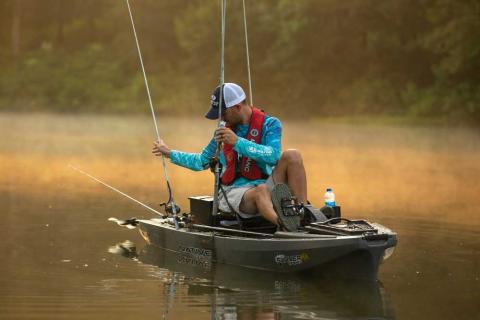DIY Catfish Rig Essentials + Fishing Gear
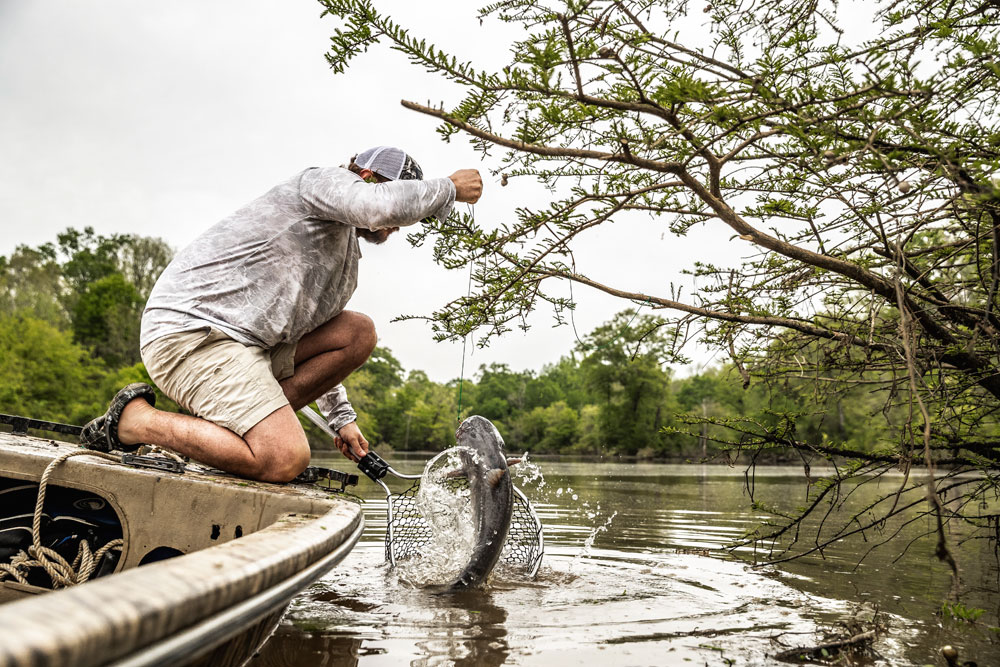
As most know, catfish are hard-fighting and delicious to eat. The equipment needed to catch catfish is inexpensive and everything you need for traditional pole fishing or any of the DIY methods listed below can be easily found at your local Walmart! In this article, we’ll cover the basics of catfishing and a few different fishing methods commonly used to put these delicious fish on your plate!
One thing to remember about catfishing, particularly in the summer, is that mosquitos and other biting critters are typically out in full force. Keep your skin covered and protected from both bugs and the sun. Check out the Mossy Oak Fishing Performance Apparel and gear that offers protection of the face and neck.
Catfish Basics
Although more than 1,000 kinds of catfish are found all over the world, 26 species of catfish live in the United States, ranging in size from one inch to the largest said to be a 315-pounder caught in the Missouri River. The North American species have barbels (whiskers) on their faces that enable catfish to find food since catfish taste through their feelers as well as their entire bodies that have more than 100,000 food sensors on them. A catfish discovers food by fanning the bottom with its barbels and honing in on vibrations – catfish can detect high frequencies at 13,000 cycles per second – and following food scents.
What Do Catfish Eat?
Catfish eat most anything, including fish like gizzard and threadfin shad, miniature marshmallows, homemade soured-food cooked mixtures like pineapple and rice, dry dog food sunk in a burlap bag, wieners, chicken livers, soap, golden raisins, commercially-prepared catfish bait, suckers, mullet, freshwater mussels, hellgrammites, worms, leeches, frogs and any decaying matter. Some prefer to catch their own bait, but for some, packaged ‘stinky baits’ are a simple and convenient alternative.There are quite a few pre-packaged catfish baits on the market. CLICK HERE to view a solid collection of baits available online.
Catfish Species
Four main species of catfish live in North America: the bullhead, the channel, the flathead, and the blue. The bullhead is one of the most widely-distributed catfish, inhabiting most of the U.S. and southern Canada. The channel catfish originally was wide-ranged from southern Canada through the Great Lakes region and the central drainage systems of the U.S. south to Mexico, as well as parts of the Atlantic Coast and all the states bordering the Gulf of Mexico. Today channel catfish also have been introduced throughout other sections of the U.S.
Flathead catfish have been introduced across the U.S. in rivers and reservoirs and have their origin in the rivers of the Mississippi Valley – Missouri, Ohio, and Mississippi – south to Mexico. The blue catfish isn’t as abundant today as it was before the erection of power dams, but still, it’s distributed in large rivers from Minnesota and Ohio southward and in the Atlantic Coastal system, with a preference for clear, swift streams flowing over bottoms of bedrock, boulders, gravel and/or sand and are known to primarily bite ‘live baits.’
DIY Catfishing Tactics
Let’s take a look at some of the easiest and least-expensive do-it-yourself ways to catch catfish with materials you can find easily at your local Walmart. Be sure to check with your local fish and wildlife section of the state’s department of conservation where you plan to fish about any regulations on the tactics used to fish for catfish to make sure they’re legal.
Noodling
Noodling is a form of fishing where people catch fish with their hands. It is illegal in some states, so it is imperative to check the state’s fishing regulations prior to attempting this method. Noodling can prove to be a very action-packed experience that may also present some forms of risk. The strategy behind successful noodling is to locate a catfish hole in a lake, river or stream. The problem with catfish holes is what may be lurking inside of or around them at any given moment. Animals such as alligators, snapping turtles, beavers, snakes, have been known to bite noodlers as they blindly reach into a hole in search of a catfish. Another major risk to noodlers comes with the frequent requirement of having to dive for catfish. Noodlers have become entangled in underwater debris or have exhausted themselves as they fight with a deep-water catfish and drowned. If you choose to embark upon noodling, it is critical to go with a seasoned noodler and a party of people that may be able to help anyone in immediate need of life rescue in the water. Some choose to ‘noodle’ with their bare hands, others prefer gloves to prevent damage to skin.
Jugging/Jugging with Pool Noodles
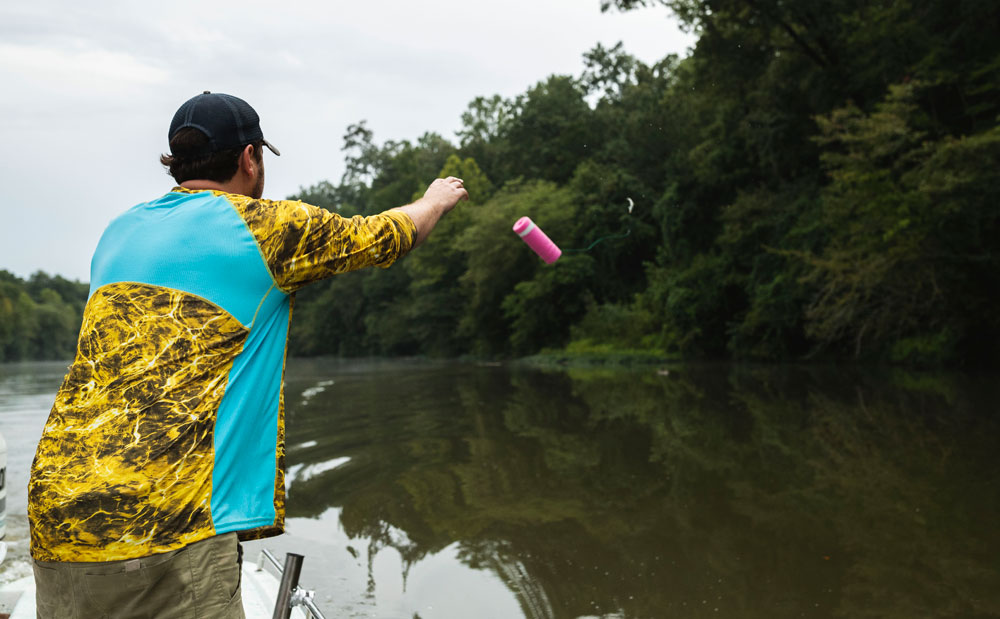
Anglers catch catfish using a wide variety of techniques. One of the simplest and easiest ways to catch catfish is by a method referred to as “jugging” or “jug lining.”
Gary Harlan of Tishomingo, Mississippi, is a professional catfish guide at Pickwick Lake on the border of Tennessee, Alabama and Mississippi, who fishes with noodles - round, styrofoam floats that children and adults both use when swimming in pools, rivers and/or lakes.
“Whether I’m fishing with youngsters or adults or a combination of both, I like to use the jugging method and catch catfish on noodles,” Harlan explains.
Noodles are productive devices to use for catfishing, too. Check out the swimming department at Walmart to find noodles or have them shipped directly to your door.
How to Rig a Jug for Catfish
There are several different methods for rigging jug lines. YouTube is a great resource to look for ideas on how to rig your own jug lines. The following steps are provided by Harlan instructing how to make your own catfishing juglines out of swimming noodles.
Step 1: Purchase the Right-Sized Noodles at Walmart
Harlan prefers the jumbo bright-colored noodles about 56-inches long, each of which will make 3 usable jugging noodles.
Step 2: Cut the Noodle Pieces to Length
Using a sharp knife, such as a fish fillet knife, cut each noodle into three sections, about 18-1/2 inches long, again giving you 3 usable jugging noodles.
Step 3: Mark each jugging noodle with your state’s required information
Using a black, big-tipped Sharpie marker, mark each jugging noodle with your contact information and any other pertinent information required by your local fish and wildlife department. Some states require your name and address while others may require more/less. The responsibility falls on anyone contributing to catching the fish to know what is required to legally pursue fish in each state.
Step 4: Rigging Jugging Noodles
Use a piece of 6 to 8-foot long stainless-steel wire, fold the wire in half, put a No. 1 to a No. 3 barrel swivel in the middle of the halved wire and twist the ends of the wire six to eight times to form a loop in the middle of the wire where the barrel swivel is attached. Then, sew the wire from inside the pool noodle to its outside, so that the wire is woven from one side of the noodle to the other side, much like lacing up a tennis shoe.
Once both ends of the wire come out the top of the noodle, twist the two ends together, leaving about 1 to 1-1/2 inches of twisted wire. Wrap the remaining wire around itself, forcing the tag end of the wire into the noodle and use pliers to tap the wire’s tag end deep into the noodle to make it lay flat on the noodle’s top.
Step 5: Attach Fishing Line
Attach 20 feet of 65-pound-test braided line to the barrel swivel at the bottom of the noodle. Then, attach snap swivels every 5 feet down the 20 feet of line. This will provide the options to fish from 5 feet to 20 feet deep by just adding a hook on the snap swivel at the water depth needing fished in. Slide a 1/4- to a 1/2-ounce egg sinker on the bottom of the line and attach a No. 2/0 to No. 3/0 circle hook to catch eating-size catfish and up to a No 7/0 hook for larger catfish.
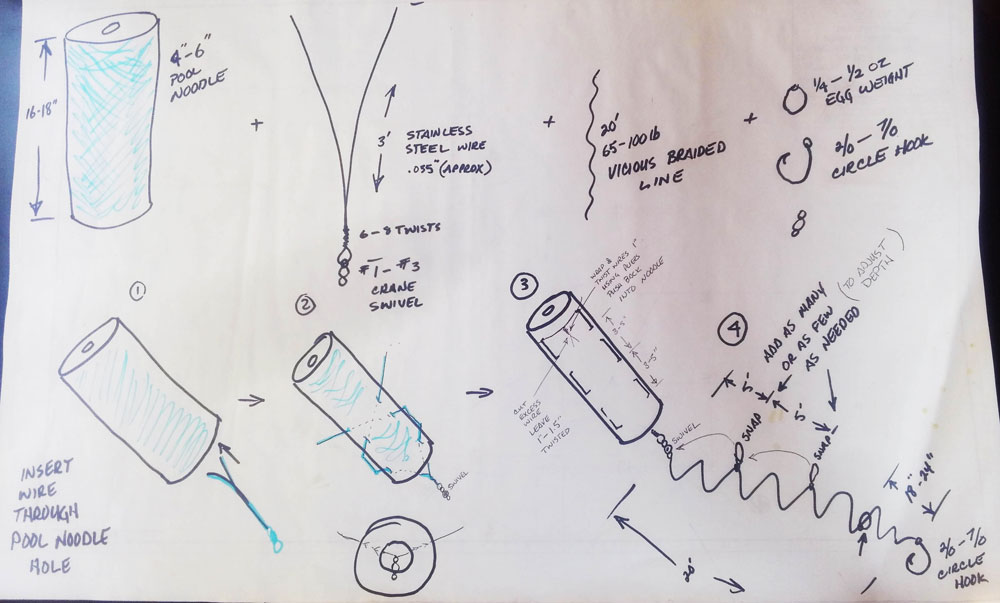
“I like circle hooks because when the catfish takes the bait, the circle hook will catch that fish,” Harlan says. “Then I rarely, if ever, miss a catfish that takes my bait. Rigging this way, I can shorten my line to as little as 3 feet if I want to fish shallow water in the summertime at night, or make it as deep as 20 feet if I’m fishing during the daytime.”
Step 6: Baiting Jugging Noodles
The best bait to use when jugging for catfish is either freshly-caught cut shad or 3 to 4-inch shad minnows cut in half for bait. Another great option available at Walmart would be any type of catfish stink bait dough bait.
Just like there are several ways to skin a cat, there are just as many ways to catch a catfish. Tony Adams, a fishing guide at Alabama’s Lake Eufaula, catches an average of 200-400 pounds of catfish on jugs in a 4-hour trip.
He says, “During the hot summer months, I’ll run the lines coming from my jugs down to 40-60 feet deep. I’ll put out about 72, 20-ounce empty plastic sports drink and soft drink bottles for catfish. I’ll paint them orange, so I can spot them easily.”
These jugs will fit neatly into the racks that drink salesmen use to carry soft drinks into stores, and they’re stackable. Then the jugs don’t take up very much room in Adams’ boat. Adams likes to have 50-60 pound test line coming off his jugs and attaches either a No. 5/0 or a No. 6/0 stainless-steel circle hook to each, when fishing for catfish weighing 20+ pounds, or a No. 2/0 or a 3/0 hook to catch eating-size catfish.
Adams fills the insides of some of the jugs with foam. “A big catfish can pull a jug down so deep that the sides of the jugs will collapse,” Adams explains. “By spraying foam in the jugs, I solve that problem. The foam creates more flotation.”
Adams baits his hooks with cut skipjack (a hickory shad) and with cut mullet (a saltwater fish that has a lot of oil in it and puts-off a strong smell). On some of his jugs, Adams uses an egg sinker above a swivel with about 18 inches of leader line below the swivel going to the hook.
According to Adams, “The weight helps the bait reach the bottom faster, and the swivel prevents the cat from rolling up in the line. When there’s little or no current, on some of my jugs, I won’t use any lead, and I’ll only have a swivel to keep the cat from twisting the line. So, when the catfish picks-up my bait, the fish won’t feel any resistance on the line, until it gets the bait well into its mouth. I’ll also put about three turns of electrical tape around my jugs to have a place to put the points of my hooks when I take in my lines. Putting the points of the hooks under the electrical tape keeps the line on the jugs from unrolling and gives me a good place to store my hooks after I’ve finished fishing. I’ll have reflective tape on the bottoms of some of the jugs. Then when I fish at night, I’ll put out the jugs with the reflective tape to make finding them easier.”
Adams tends to put his jugs out in a straight line on the edge of a river or a creek channel. He explains that “When I put my jugs on the edge of a river channel, the wind either will blow the jugs on top of the river channel or out over the river channel. The catfish will relate to that river channel, especially in the hot summertime, as well as in the fall when they’ll often suspend over a river channel. The easiest way to determine if you’ve got a cat on a jug or not is to put your jugs out in a straight line. Then when you start running your jugs, if you see a jug off to the left or to the right of that line, you know you’ve either caught a cat, or a cat has taken your bait. Most of the time, if a jug isn’t in that straight line where you’ve put it, it will have a catfish on it.”
Adams uses a fairly stiff BnM pole with a large bass hook attached to the last eyelet on the pole to pick up his jugs quickly and play a catfish down. “Then I can get the catfish to the surface quicker and get it up to the side of the boat. If the cat is so big that I have to turn loose of the pole to keep from breaking it, the pole will float back to the surface before the jug does.”
Fishing Limb Lines, Set Poles and Yo-Yos on Small Streams and Little Rivers Close to Home
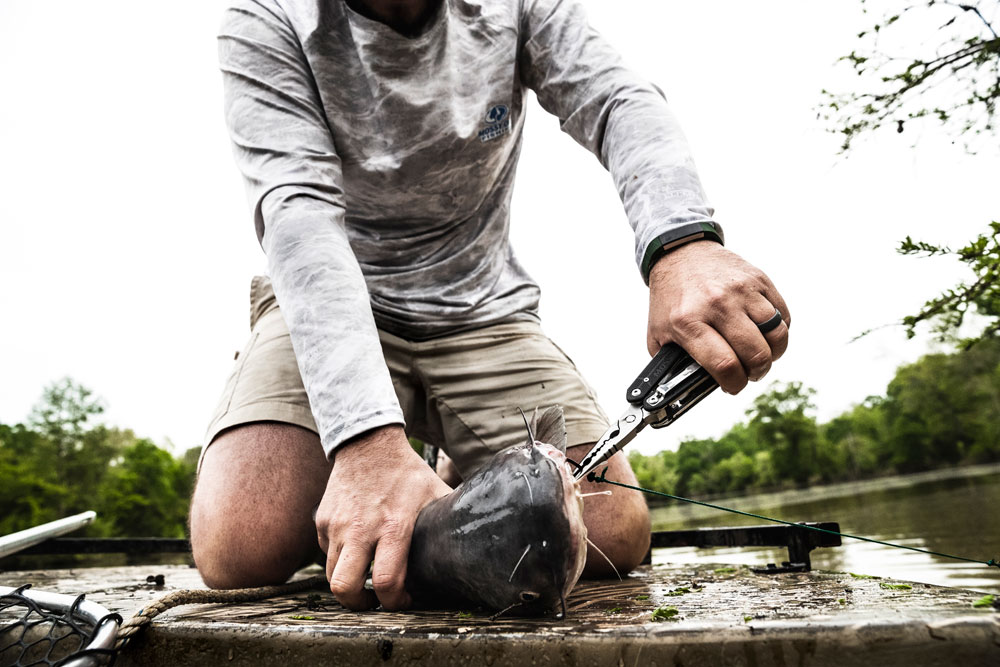
Some of the most overlooked, highly-productive areas to catch plenty of catfish are in the thousands of small streams and little rivers throughout the nation. You'll often find these streams close to home or within easy driving distance. Some of these waters may be no more than 20 yards wide. The fisheries section of your state’s department of conservation usually can tell you the location of small streams and little rivers that may hold catfish.
You can pinpoint catfish hotspots, like current breaks and boulders that form eddy pools on their down-current sides, from the banks of these small waters. Cast a live redworm out to the eddy pool, and you’ll instantly hook a catfish.
Another successful technique for fishing small waters is to float them in a canoe or a flat-bottomed johnboat equipped with a depth finder. Use the depth finder to locate sharp bottom breaks and underwater boulders. Once you've pinpointed these places, anchor upstream, and let your bait wash into these regions where catfish will hold. These underwater catfish hot spots often go virtually unfished and generally will hold plenty of cats for the catching. Small boat anglers enjoy using the Humminbird Helix 7 G3 Fish Finder with its clear, sharp underwater views for seeing 200 feet to each side of the boat and the PiranhaMax 4 that features a narrow and a wide beam for great detail, helping you identify catfish, the structure and contours of the bottom under the water.
Limblining
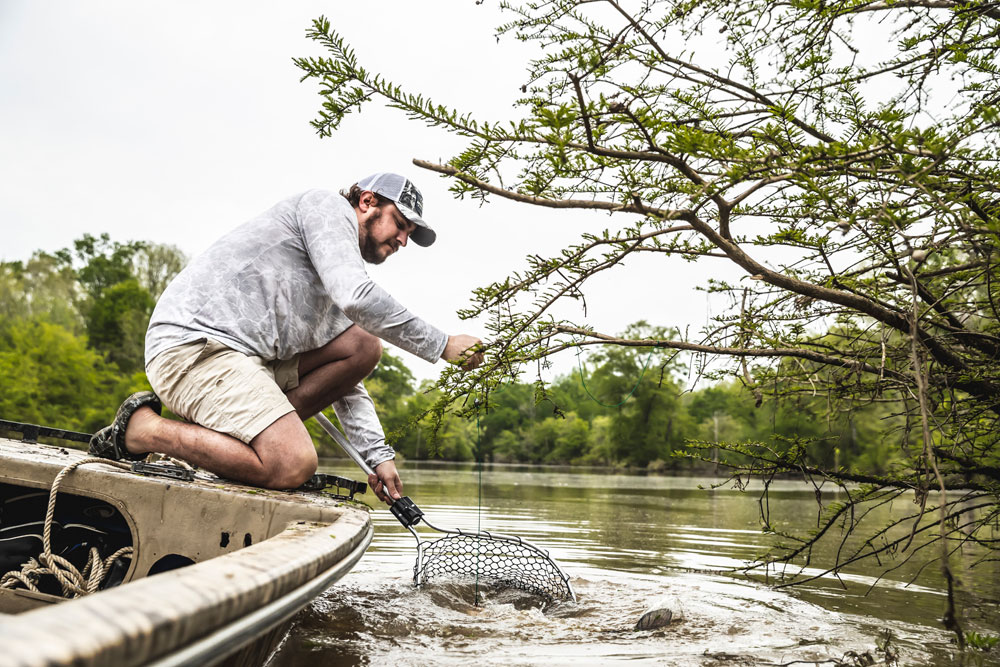
If you’re fishing down small rivers and creeks, you can fish for catfish by setting out limblines and set poles, also called bush lines, along the bank. By tying a line of braided nylon twine with a circle hook or straight hook of your size and choice depending on the size of the fish you are targeting. Bait the hook and tie the nylon braid to a solid tree limb that’s overhanging the water, you can fish a large area with a small amount of tackle to improve your chances of catching catfish. Always be sure the limb you tie your line to is green and not brittle. Since a nice-sized catfish will put pressure on a limb, the branch should bend and not break under that pressure. Also, set your lines at different depths to determine where the fish are. A shaking bush usually means a fish dinner.
Landing a big catfish on a limb line is much like landing a cat on a jug. Don't try to wrestle the catfish to the surface with the line. Often the catfish will dive and either break the line or jerk it off the limb. Instead, gently lead the catfish to the surface, and slip your net under it.
Set-Poling
Set poles are similar to limb lines, except a set pole is a small limb or a river cane that has been sharpened on its big end and then stuck into the soft earth of the bank and baited. Remember with this method to position the pole at about a 45-degree angle, so that when the catfish takes the bait, the pole will bend and not pull out from the bank, while awaiting your return to check it.
Yo-Yoing
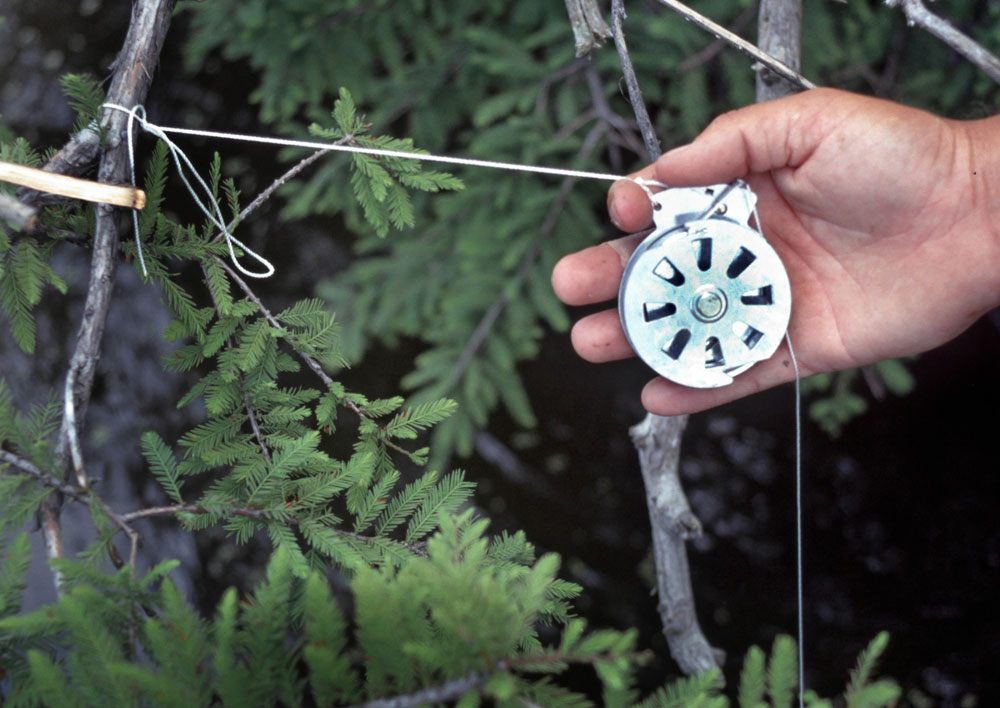
Billy Blakely, a fishing guide on Reelfoot Lake near Tiptonville, Tennessee, on the Mississippi River near the borders of Kentucky, Arkansas, and Missouri, names Yo-Yos, which you can buy at Walmart, as: “The best catfish-catching machines in the world. On an average 4-6 hour trip, in the daytime or at night, each Yo-Yo will produce about 1 1/2 pounds of catfish. Yo-Yo fishing will produce catfish on almost any lake, river or stream in the nation. You can fish Yo-Yos for catfish in the South when the temperature soars over 100 degrees or through the ice in the North in winter's below-freezing temperatures.”
A Yo-Yo, an automatic fishing reel produced by Mechanical Fisher, consists of a stainless-steel spring enclosed in a sheet-metal frame. The small circular device has a line attached to the top end that you use to tie the Yo-Yo to a green limb of a tree hanging out over the water. The lower end of the Yo-Yo contains 20 feet of coiled trotline staging with a snap swivel on the end of the line. To fish with the Yo-Yo, attach a No. 2/0 hook to the snap swivel, and put a small piece of shot lead 6 to 8 inches up the line from the swivel.
As you pull out the line on the bottom end of the Yo-Yo, the stainless-steel spring will coil tighter and tighter. When you've pulled out the desired amount of line to fish the water depth you want, you engage a small wire trigger on the side of the reel. The trigger holds the reel in place, and the spring inside the reel is coiled tightly. When a catfish takes the bait, it trips the trigger, causing the spring to uncoil quickly, which sets the hook and keeps tension on the line. As the catfish swims away from the Yo-Yo, the stainless-steel spring becomes even more tightly. When the catfish quits swimming, the spring jerks the line, pulling the fish back under the tree.
If you fish with the Yo-Yo instead of the standard limb line, the Yo-Yo will:
- set the hook with a quick jerk,
- keep constant pressure on the hook, preventing the catfish from escaping,
- add more pressure to the line the further the catfish swims away from the tree,
- keep the line from getting tangled in underwater logs and limbs by pulling the catfish up and away from the bottom each time it runs,
- play the fish as it runs from the tree and then pulls the catfish back to the tree and
- pull the catfish's head up out of the water or near the surface to let you know you have a fish on the line, day or night.
Although some fishermen just grab hold of the line and swing the cat in the boat, serious catfish anglers know they’ll lose far fewer cats by sliding a dip net under them and using the dip net to bring them into the boat.
Trotlining
More trotline videos via our streaming app, Mossy Oak GO.
Catching catfish with trotlines is very fun and a great way to provide family and friends with some of the best table fare there is. While many anglers have their go-to ways of catching catfish, there are several timeless tips and tricks out there that may lead to many more fish on your trotline than the next angler.
Building a trotline for catfishing can prove to be a relatively simple way to catch a large amount of catfish with minimal effort. The supplies required to build your own trotline can all be acquired at Walmart and are relatively affordable for the yield of catfish they can all provide. A list of trotline supplies can be found here.
When it comes to catching catfish on a trotline, your trotline will only be as attractive as the bait you put on each hook. It is important to know that different subspecies of catfish prefer different types of food. Knowing which subspecies of catfish you’re targeting will help you determine what type of bait to use on your trotline. Some subspecies of catfish prefer live bait, while others prefer lifeless bait.
To see the catfishing equipment available at Walmart, visit www.walmart.com/Fishing.















